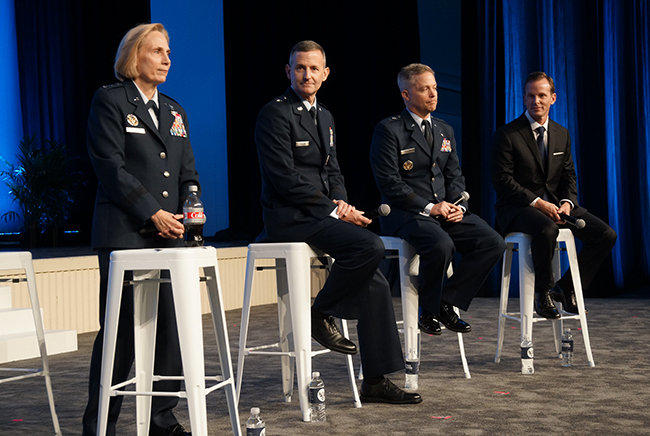
Lt. Gen. VeraLinn “Dash” Jamieson, USAF deputy chief of staff for intelligence, surveillance, and reconnaissance, and cyber effects operations, Brig. Gen. Bradley Pyburn, Air Force director of cyberspace operations and warfighter communications, Maj. Gen. Timothy Haugh, the nominee to command the service's new information warfare unit, the 16th Air Force, and David Brumley, computer science professor at Carnegie Mellon University, appear at the AFA's 2019 Air, Space and Cyber Conference on Sept. 18, 2019. Staff photo by Mike Tsukamoto.
The Air Force has released an infographic summarizing its “cyber flight plan”—a highly classified document outlining one of the four pillars the service plans to use to engage the nation’s adversaries in the grey zone of hybrid warfare.
According to the infographic, the flight plan lays out three “lines of effort” in cyber, as well as seven annexes, dealing with policy areas the authors believe require emphasis.
The three lines of effort are:
- Foundational capabilities: talent management and training
- Readiness and lethality: growing operational capabilities
- Emerging/disruptive technologies: using open architecture and agile development to “bring new capabilities to the fight.”
And that fight is going on right now, Lt. Gen. VeraLinn “Dash” Jamieson, the service’s deputy chief of staff for intelligence, surveillance, and reconnaissance, and cyber effects operations, whose shop produced the flight plan, told reporters at the AFA’s Air, Space and Cyber Conference on Sept 18.
“I’m not at peacetime,” she said.
“Right now, today, in the cyber domain, in information operations, I am not at peace. I am in persistent conflict” with Russia and other adversaries, like the Chinese, who are engaged in stealing US intellectual property, including by violating the trademarks of US companies, she said.
“We are in conflict today,” Jamieson said, outlining that cyberwarfare operations is one of the four pillars of the Air Force’s emerging information warfare doctrine—also visible in the service’s decision to merge the 24th and 25th Air Forces into the 16th.
“It’s math,” Jamieson said. “Information warfare equals cyber warfare plus electromagnetic warfare, plus information operations and ISR.” Jamieson’s office—designated as A2/6—produced the ISR flight plan last year, and is working on plans for electromagnetic warfare and information operations.
She said the plan was the result of “long, hard discussions” with other services. “We are really coming together to understand this non-kinetic capability” that America’s adversaries are deploying, “capabilities that don’t necessarily go boom,” she said.
The key for the new fight—laid out in the cyber flight plan—is combining those four pillars in “creative” ways, Jamieson said. “It isn’t the pieces, it’s integrating all of that.”
The two-page handout includes “A quick sentence on … every element of the flight plan at the unclassified level,” she explained. Classified versions of the document laid out greater detail, she said.
Brig. Gen. Bradley Pyburn, Air Force director of cyberspace operations and warfighter communications, outlined the seven annexes:
- Human capital: “It all starts with human capital. We have to be able to recruit, retain, and develop talent in this battlespace … It’s tough… In cyber we can’t compete on dollars alone. We have to compete on mission, and opportunity, and a calling to something larger than ourselves,” Pyburn said.
- ISR: “Intelligence is going to drive and underpin every operation” in cyberspace. “How do we get intelligence from cyber that informs multi-domain operations and how do we generate intelligence that will inform cyberspace operations as we seek to hold enemy capabilities at risk”
- Defensive cyber operations: “Defending (our) weapons systems” so they can fight through enemy cyberattacks.
- Offensive cyber operations: “Opportunities for air component commanders … through our new integrated app,” LevelUP or the Unified Platform.
- Warfighting communications: “We have to be able to communicate in a contested and degraded environment.”
- Emerging and disruptive technologies.
- Partnerships with industry.